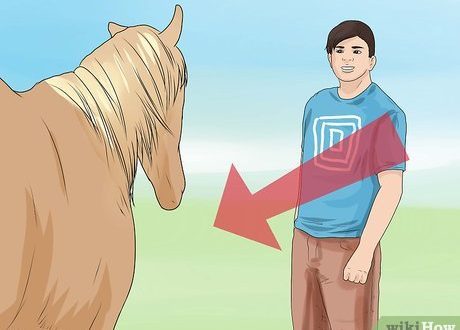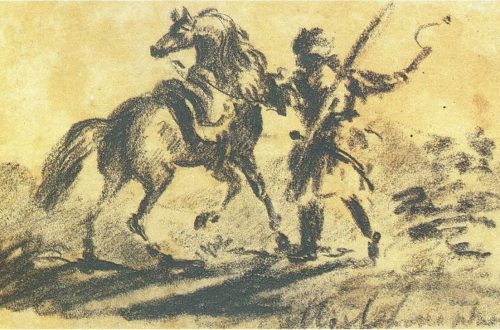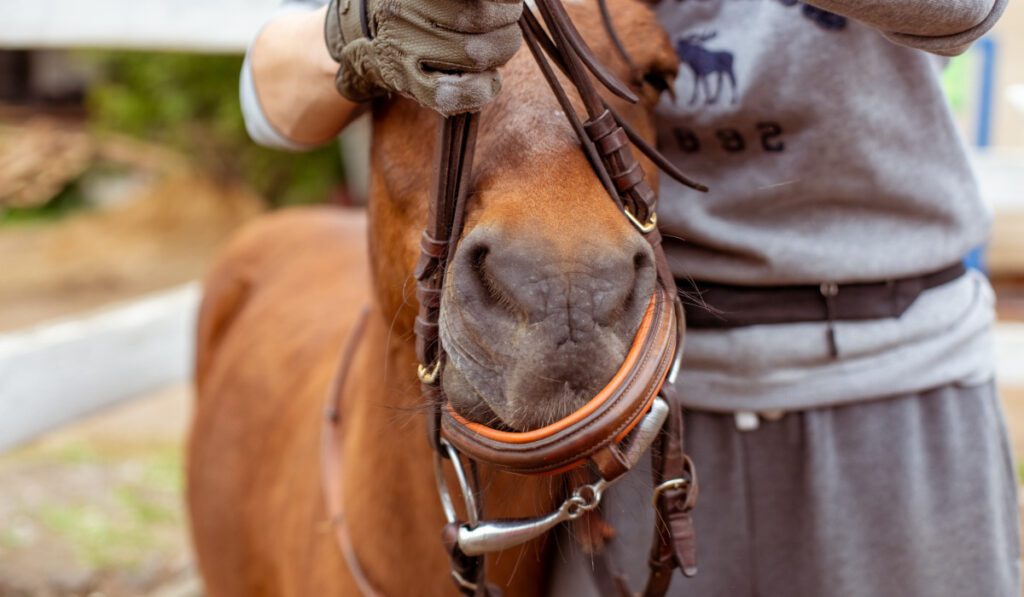
Take the fear by the bridle!
Take the fear by the bridle!
How to really intimidate a rider? Horses know several ways. However, this does not mean that they should be feared. You just have to know how to handle a situation where the horse wants the rider to be terrified.
If you are already completely “loose”, then it will not be easy to pull yourself together, so it is best not to be afraid of anything from the very beginning. You need to keep the situation under control and not let the horse take the lead.
Horse bites and kicks
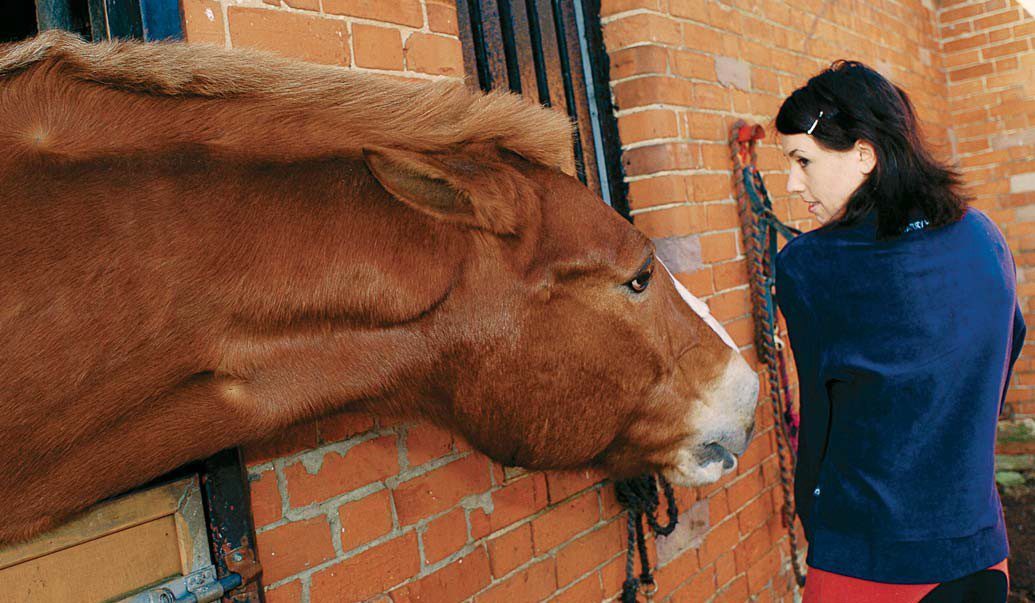
Many horses bite and kick with their hind legs because they have experienced severe stressful situations in the past that they remember. still . Perhaps the people were mistreated with them – mocked and beaten, as a result, the horses began to perceive any person as a threat.
To help such a horse, first try to understand the reasons for its aggressive behavior. And, if it’s not bad memories, perhaps it’s a reaction to some current circumstances. If the horse is constantly in the stable and does not walk in the levada, does not work much or is very tired, then as a protest he may start to beat or bite.
The horse can also react to your actions: if you put too much pressure on him, he is nervous. Horses, like people, need personal space and may object to your intrusion into it.
What to do?
While working with your horse, be calm and relaxed, but at the same time watch his behavior and try to anticipate his actions in advance. As a herd animal, the horse needs a leader. Show her that you are the leader. However, power should not be abused. Usually a horse will warn you that it is about to bite by either pinching its ears or grimacing.
The horse must understand that he cannot invade your personal space, unless you invite him yourself. If you see a horse about to bite you, stand up straight and raise your hand up sharply – not to hit him, but to show that you are not going to run away from him. If the horse is in a halter, pull on the halter to keep him at a sufficient distance from you, or force him to step back.
When the horse stops bullying you, release the pressure but stay where you are. Soon she will understand not only that you cannot be pushed around, but also that you are not going to hurt her. Every time a horse tries to bite you, you should take the same actions. If a horse lunges at you, try spraying it with water from a spray bottle. This should stop and scare her a little.
Kisses and hugs usually invite the horse to “play”, and therefore, she understands that no one forbade biting during the game. Such “entertainment” can be really dangerous for you.
If the horse kicks with its hind legsshow her that you can control her. Pull on the lead and turn its head towards you, and in the meantime, lightly slap the end of the lead on its hind legs, causing the horse to step aside. If she gives in, stop her. Repeat this as often as possible. If the horse kicks when you touch his leg, try using a whip with a “glove” attached to it. You can touch his leg from a distance until the horse stops resisting. When she complies with your request, give her a reassuring pat on the neck.
If the horse still bites or kicks with its hind legs despite all your precautionary actions, it is probably dangerous. Consult with an equine behavior professional!
Refusals
Zakidka – a sharp stop of the horse and a categorical refusal to move forward. Very often it is accompanied by the fact that the horse rears up, reins or spins in place. If a horse regularly repeats taunts, it has developed a bad habit. This usually happens on walks in the field or in the woods, in front of an obstacle, or when other horses are left behind, such as when she does not want to leave the horse station at a competition.
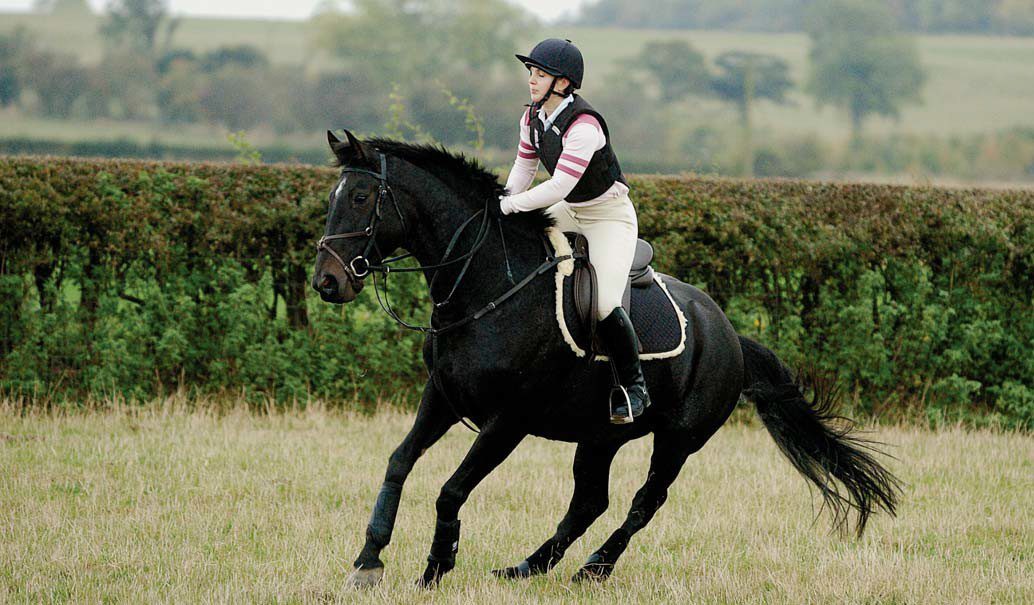
After the abandonment, the horse maythe same to turn to the side, stand on its hind legs or jump sharply in the opposite direction.
Why?
● In the wild, horses, sensing danger, flee. They would rather run away from the problem than face it. Riders should learn to deal with this reaction and teach the horse not to be afraid of “monsters”.
● Some horses throw themselves because they know they can outmaneuver a human. This often happens if a novice or insecure rider is riding.
● Refusing can be a signal that the horse is experiencing pain in the back, neck or mouth.
What to do?
From the very beginning, check the back and teeth of the horse.
Go for walks with other horses – this will give both of you confidence.
Solve the problem as soon as it arises. Otherwise, you can be squeezed, and your horse is with you. Try singing while driving – it helps a lot!
If the horse throws up and you are a confident rider, this will force you to be more collected. Perhaps you feel that you cannot do it alone, then seek the help of a more experienced rider or instructor. Ask them to ride your pet for a walk to understand the situation and help you deal with it.
A well-trained horse is less likely to give up. Take the time to practice dressage, especially pay attention to how she executes the “Forward!” command. Remember: you are the leader for the horse. She must obey you.
Work on your relationship with the horse. Do simple exercises on the ground, this will help you strengthen your leadership status.
Treat your walk in nature as an extension of your horse’s education.
During the walk, make her work properly and perform various exercises. Make transitions, lateral movements, etc. If the horse is busy listening to you, it is unlikely that he will remember the rejections.
The horse will always warn you that it is about to pounce.
Typical signs of a throw: The horse pinches, raises its head, pricks up its ears, bounces in place, or slows down. Send the horse forward, pushing it with the body, click the tongue. If that doesn’t work, turn the horse a small circle and go 4-5 times and then push the horse forward. If it still throws, turn it the other way five or six paces, and then push it forward again. Repeat this until the horse relaxes and calms down.
When preparing for a walk, choose the right equipment, and for yourself, a safety helmet and (if possible) a safety vest.
If you find yourself in an awkward situation, don’t be afraid to get off your horse and move it around in your arms until it calms down. Don’t take it as a defeat: the horse will be grateful to you for taking responsibility for what is happening and helping him.
The horse “pulls”
When the horse “carried”, it’s scary. You were confused, the horse panicked and became uncontrollable. Anything can wait ahead of you: a collision with a car, people, obstacles, but your horse doesn’t care. Fortunately, situations of this type are extremely rare, but they are not easy to deal with. When riders say that their horse has run, they usually mean that the horse was out of control for a while. This is also scary, but not so dangerous.
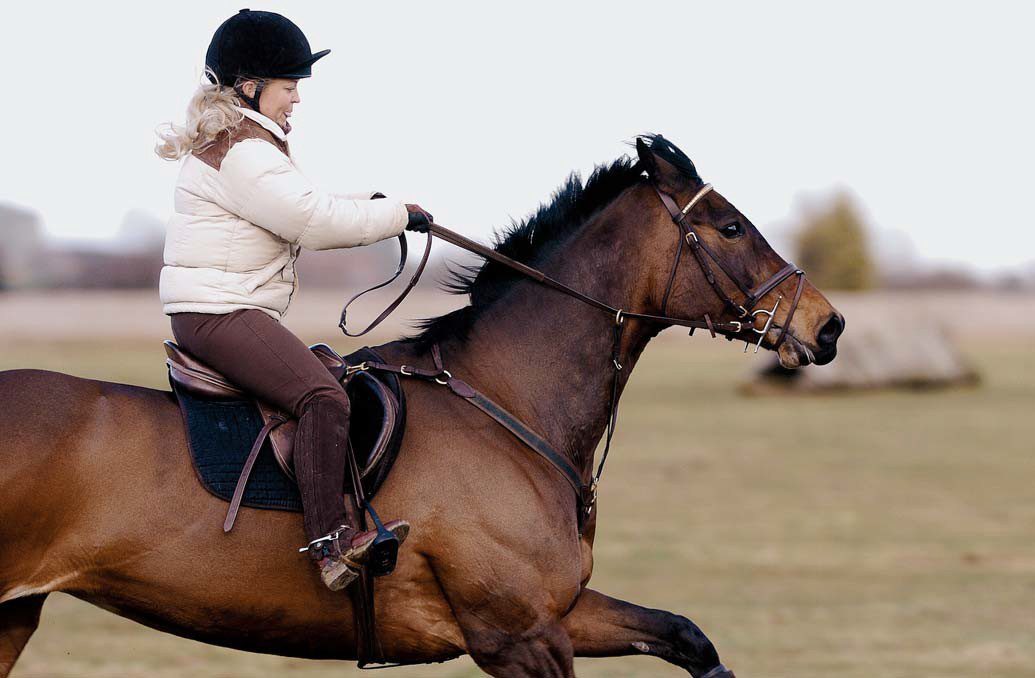
Why?
● The horse is not ridden or naughty.
● The horse is overjoyed.
● The horse was in anticipation of a gallop.
● The horse is overfed.
● The rider indulges the horse too much and cannot handle it.
● The horse is in pain due to ill-fitting equipment.
What to do?
A well-trained horse most likely will not even think about “carrying”.
While the horse is not well ridden, avoid situations that may provoke him to resist. For example, don’t go on nature walks with lots of horses.
If you don’t know how to deal with different situations, ask for help or advice from an experienced person.
Resume dressage with your horse. The horse must obey your commands, so work on transitions more.
If you always do an extended canter in the same place, your horse is used to it and may run wild as you approach that section of the path. So every time you go for a walk, change your speed and routes.
If the horse is playing hard, do an extended canter uphill. The horse will not be able to go uphill too fast and will soon get tired.
If the horse is running, sit up straight, because leaning forward weakens your seat. Use the reins to form a bridge over the withers of the horse and do short and very strong half halts. If you can, turn the horse up to a large circle and then gradually reduce it until you can control the horse again.
As a last resort, you can change the iron to a more severe one (for example, a pelyam or an Olympic three-ring snaffle). Try several types of iron to see which one the horse reacts to. the best thing .
The horse runs around an obstacle
Run-off is a common problem in show jumping horses.
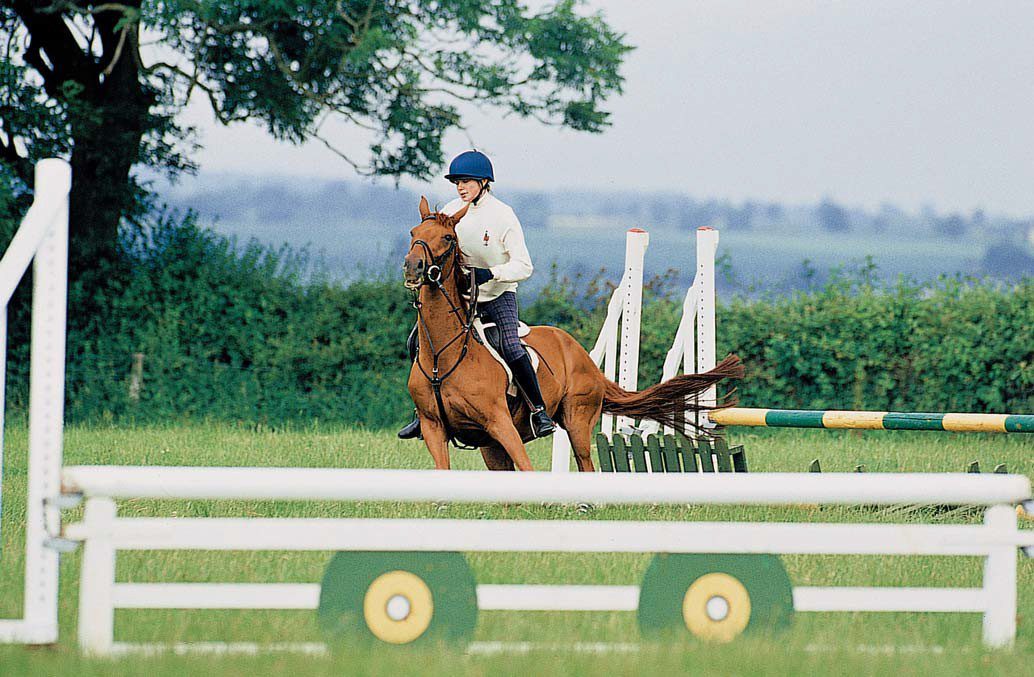
Why?
- The obstacle is too difficult or unfamiliar, and the horse is not sure he can overcome it.
- You approached the obstacle not in a straight line, or the canter was not energetic enough.
- The horse does not fit the equipment, perhaps it hurts him.
- Light: A horse’s eyes don’t readjust too quickly when he comes out of the dark into the light, so the horse may not see obstacles.
- Bad soil.
- Pain: If your horse is constantly shedding, ask your veterinarian to examine him.
- The horse is tired or lazy.
- Rider error. When seated incorrectly, you tug on the horse’s mouth or land sloppily after a jump. In the end, the horse may run out of patience.
What to do?
If the horse has become constantly over obstacles, return to the initial training. Work at a trot over the poles – this will force the horse forward and straight. When the horse can confidently pass through them, place an obstacle in place of the last pole, continue to trot and overcome the obstacle as if it were a pole lying on the ground.
Maintain constant contact with the horse. If you drop the reins in front of an obstacle, the horse will have every reason to do what he wants.
To prevent the horse from running away, place the keys along the arena wall. Using the crosses helps the horse to go straight and you to aim for the middle of the obstacle.
If the horse stops, don’t panic. When approaching an obstacle, lead him straight, keep your foot down, and soon the horse will realize that he has no choice but to jump.
Don’t fight the horse for a long time. If it keeps moving away from the same obstacle, lower it just enough so that the horse feels confident going over it.
So that the horse does not get excited at the sight of unusual obstacles, train more. Do not jump high obstacles, let them be of various types. Use straw bales, blue plastic, and barrels—anything that can look out of the ordinary.
Get yourself an assistant. It doesn’t have to be an instructor. An experienced friend who can give you some guidance will build your confidence.
The horse kicks with its hind legs
In the wild, horses kick with their hind legs to defend themselves from predators that might jump on their backs. However, if a horse under saddle kicks backwards, it is dangerous for the rider, and therefore unacceptably.
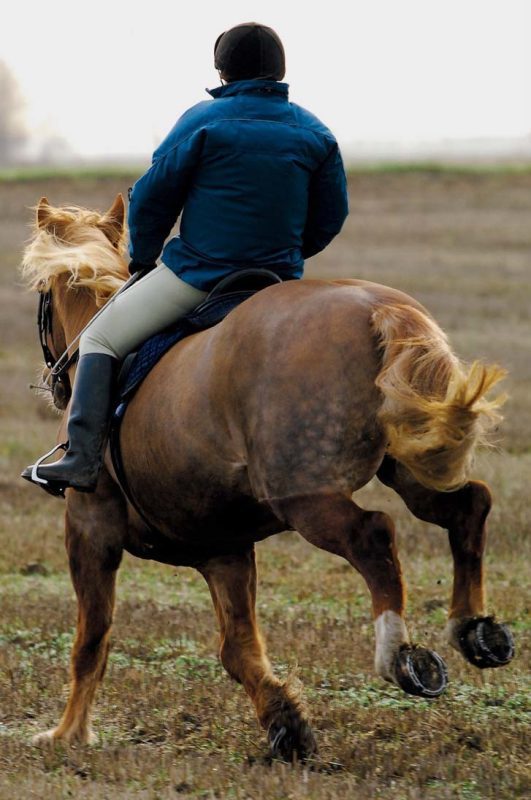
Why?
● The horse is too excited.
● She has an excess of energy.
● Too cold and the horse has recently been shaved.
● Something hurts the horse, more often all because of ill-fitting equipment.
● She is playing.
● Habit: Horses often kick when the rider gives the command to canter or when they land after an obstacle. The horse is difficult to wean from this.
● An inexperienced and inattentive rider who pulls the horse by the mouth will soon get tired of it. Kicking back is a way to protest.
● The horse has a sensitive back.
● Sometimes the horse simply mocks the rider.
What to do?
Look at the physical causes first. Check the horse’s back, gear, and teeth and ask a nutritionist/veterinarian to adjust the diet. You may be feeding your horse too much for his load level.
If your horse is about to kick, you can tell by a few signs. At this point, you urgently need to do something – don’t wait until it’s too late.
If the horse lowers his head and slows down, lean back far behind the vertical line, take a shorter rein and lift the horse’s head up. Your leg should be stretched forward more than usual, and the heel should be lowered. Keep moving the horse forward. It will be harder for her to kick backwards if her hind legs are loaded with the rider’s weight.
Riding on the circle will help you: since the horse will need to catch the balance, he will be focused on it. When the horse realizes that he can’t hit with his backside, he will stop doing it. Be firm and confident. If you lack confidence, ask more experienced horsemen for support.
The horse is scared
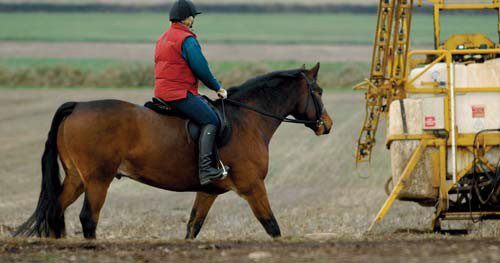
Fright in a horse is a natural reaction. If a horse is afraid of something, say, noise, people, dogs, etc., it may jump off to the side without thinking about anything (just like it would react in the wild). “Aggravating” circumstances – cold wind and young age.
What to do?
Stay alert at all times. It will be better if you notice the scary object before the horse notices it.
If a horse has been frightened at least once, it can be afraid every time it passes by this place, even if the thing that terrified it has not been there for a long time.
Remain calm: panic will not help you. Try to talk to the horse – so you can breathe measuredly and evenly.
Don’t be afraid of anything. If you yourself are scared, your horse will definitely feel it and react.
If you see something that the horse is likely to be afraid of, then, as you approach this object, turn its head in the other direction. Apply firm pressure on the inside rein and lightly pull on the outside rein. Your leg should be behind the girth to push the horse’s hind legs towards the object. Such actions are especially important on the road.
Remember that by turning the horse’s head away from the object of fear, you will have better control of the animal.
Once you have control of the horse, turn its head so it can see the scary object. If the horse is standing still, praise him. You will be safe if you try to keep your hands as close to the horse’s neck as possible. If you feel that it is not safe to show the horse a frightening object, do not show it, but ride confidently forward.
A well-trained horse is never strong will not be frightened, and if she is frightened, it will be easier to calm her down. Work on transitions, lateral movements, front and rear turns. This will make the horse more mobile and give him confidence in himself and in you.
The horse rears up
Standing up on its hind legs or on the “candle” is especially dangerous – here even the most experienced rider doubts himself. Only a professional can handle this. Do not try to fight with a horse standing on a “candle” yourself.

Why?
● The habit of giving up.
● Laziness – an attempt to avoid work.
● Too rough rider.
● Too strict iron.
● The horse is being asked to collect more than it can handle at the moment.
What to do?
When a horse rears up, there is a danger that it will rise too high, lose balance and fall back. Lean forward and wrap your arms around the horse’s neck. Do not grab the reins to hold onto the saddle, as this can tip the horse over. When the horse is on the ground, vigorously lift it into a trot. Moving forward will help you avoid further candles. If the horse follows your command, praise it.
If you carefully monitor the behavior of the horse, you can protect yourself in advance. To rear up, the horse must stop, raise its head and bring its hind legs under it. When this happens, turn it a small volt and make it move forward. To maintain a strong inward bend, actively work with the inside arm. Keep your hands down to keep the horse from raising its head. Until you get your horse to stop standing on the candle, do not ask him to start training.
Julia Brown, Hannah Roche.
The material is published with the permission of the copyright holder – the magazine “My horse” (“My horse”).



